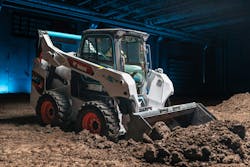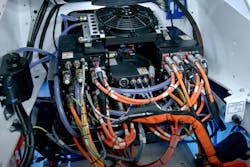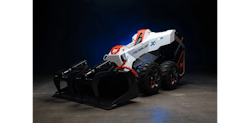All-Electric Industrial Equipment Integrates Advanced Tech
Check out Electronic Design's coverage of CES 2024.
What you’ll learn:
- What electric vehicles are currently being offered by Doosan?
- Why the S7X series is important.
- What technology will Doosan deliver in the future?
Doosan Bobcat provides a range of compact construction equipment from mini-loaders to forklifts. Some of the larger vehicles are going all-electric with the capability for autonomous operation. I talked with Joel Honeyman, Vice President of Global Innovation, about the company’s latest platforms, some of which are shipping now (see the video above).
Among the new platforms are the T7X and S7X skid-steer loaders (Fig. 1). These all-electric, zero-emissions vehicles have half the components of a conventional diesel/hydraulic loader. Top speed is 7.8 miles/hour. The cabin interior features a transparent display panel that provides the operator with information about the vehicle’s status.
Its brushless, permanent-magnet motor runs off 72.6-kWh, lithium-ion batteries (Fig. 2). The batteries can be charged using a 220/240-V, 50-A service.
2. The Bobcat T7X and S7X have some impressive stats. (Doosan Bobcat)
The exterior noise level tops out at 92.7 dB, while the interior cabin reaches only 65.4 dB. That’s quieter than diesel/hydraulic solutions, enabling the Bobcats to operate with less noise.
Remote operation is provided by Doosan Bobcat’s MaxControl Remote. It uses a smartphone application to control and maneuver the loader. This can be useful for chores like loading and unloading from a trailer or performing other operations such as digging post holes using attachments.
The design of the electric system uses half the components of a conventional system and cuts fluids by 96% (Fig. 3). This also simplifies maintenance and troubleshooting because of the additional electronics in the system.
The RogueX2 (Fig. 4) is a concept vehicle at this point. It’s designed to be autonomous or semi-autonomous and lacks the cab of the T7X and S7X. This further simplifies the design, but means remote operation is required for user intervention.



